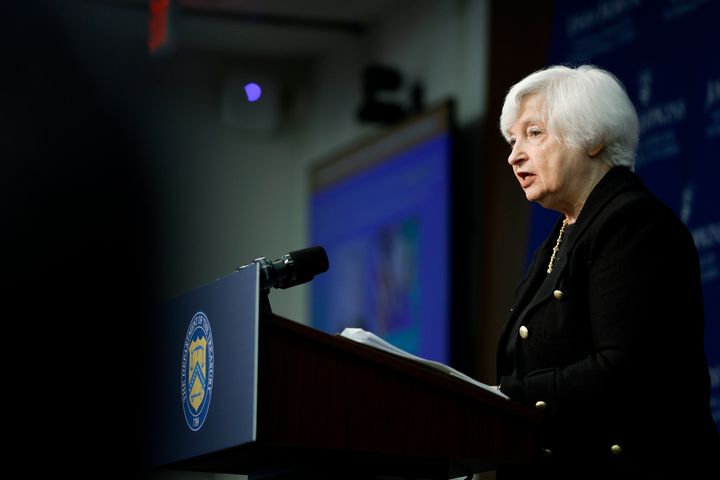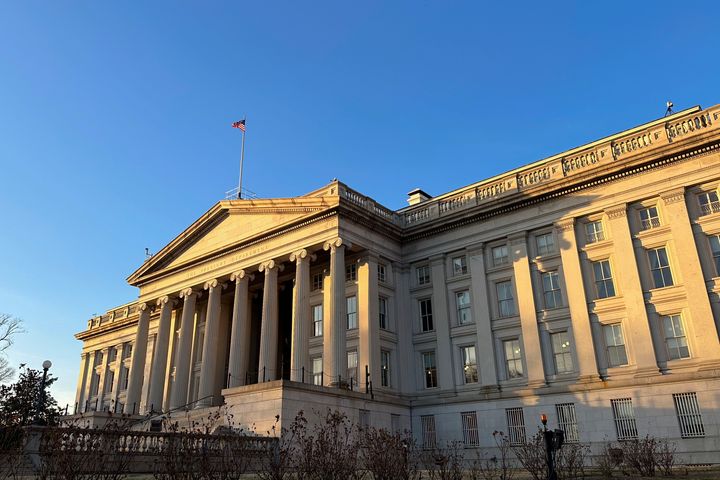No one’s quite sure exactly what the American economy would look like after a government debt default, but economists are sure of one thing: It would be bad.
Very bad. Like “dogs and cats living together” bad.
House Republicans insist they will not vote to increase the debt ceiling without as-yet unspecified steep spending cuts, but President Joe Biden has said he will not negotiate over the full faith and credit of the country.
The debt ceiling standoff went from simmering to the front burner on Monday with Treasury Secretary Janet Yellen’s warning the government could run out of cash in early June, and experts are warning that failing to give Treasury more borrowing room before it defaults would have catastrophic fallout, not just on Wall Street but also on Main Street.
“Our economy is made up of people. So when people are not doing well, our economy is not doing well,” said Rakeen Mabud, chief economist with the left-leaning Groundwork Collaborative, a group of progressive economic experts.
“Seniors wouldn’t get their Social Security checks, military service members wouldn’t get paid, families wouldn’t get some cash that they need to pay for food. And that would be an absolutely devastating economic consequence.”

Douglas Holtz-Eakin, a former director of the Congressional Budget Office and president of the conservative American Action Forum think tank, said the economic spiral downward would begin with panicky investors selling off Treasury debt.
Because that debt serves as the benchmark by which other things like mortgages and credit cards are priced, a selloff would lead to a spike in interest rates. He said that chaos would ensue in financial markets, with the final result being the end of the U.S. dollar’s status as the basic unit of the global economy.
“You’ll likely get financial chaos and a recession and no particular path forward because there is no other reserve currency on the globe right now. And so something would have to step in, and it’s not obvious what that would be,” he said.
And the Federal Reserve, which usually floods the economy with money in such crises, would not necessarily be able to help, its chairman said Wednesday.
“No one should assume that the Fed can protect the economy from the potential, you know, short- and long-term effects of a failure to pay our bills on time,” Jerome Powell said at his press conference Wednesday following the central bank’s rate-setting meeting.
Powell said the idea of the United States not paying its bills should not even be considered. “It just — it just shouldn’t be a thing,” he said.
“No one should assume that the Fed can protect the economy from the potential, you know, short- and long-term effects of a failure to pay our bills on time.”
- Federal Reserve Chairman Jerome Powell
There have been attempts to quantify exactly how bad things could get. While they differ in the details, the answer is still pretty bad.
The White House’s Council of Economic Advisers (CEA) said Wednesday a protracted default would result in 8.3 million more people unemployed and the jobless rate shooting up by 5 percentage points. In addition, the stock market in the first quarter of the default would be down 45%, it said.
“Because the government would be unable to enact counter-cyclical measures in a breach-induced recession, there would be limited policy options to help buffer the impact on households and businesses,” the CEA warned.
About 7 million people would be made jobless, pushing the unemployment rate to 8% from its current 3.5%, according to Mark Zandi, chief economist with financial analysis firm Moody’s Analytics. Economic growth would decline by 4% before bottoming out in his projection.
“Based on simulations of the Moody’s Analytics model of the U.S. and global economies, the economic downturn that would ensue would be comparable to that suffered during the global financial crisis,” he said in testimony before the Senate Banking Committee in March.
Zandi was an adviser to Republican presidential candidate John McCain but has found favor from Democrats in recent years.
Brookings Institution economists Wendy Edelberg and Louise Sheiner said just the prospect of defaulting could raise interest rates. They pointed to estimates that the government can borrow at about a quarter-percentage point less than other countries because of investors’ appetite for risk-free Treasury debt.
“You’ll likely get financial chaos and a recession and no particular path forward because there is no other reserve currency on the globe right now.”
- Douglas Holtz-Eakin, former director of the Congressional Budget Office
If that premium disappeared, they said, it could cost $50 billion next year and a cumulative $750 billion over the next decade in higher interest costs.
And it’s not like the Treasury market is in great shape, after years of having to absorb increased deficits caused by spending under former President Donald Trump, then for COVID measures and again under President Joe Biden.
Peter Orszag, another former CBO director and Barack Obama’s budget director, said Tuesday on CNBC the difference between the prices bond buyers have been willing to offer and what bond sellers have been willing to accept has widened, signaling a weaker market.
“The Treasury market is less liquid than it has been historically, which means, if there are tremors, they can have pronounced impact,” he said.
And there are some small signs of jitters already.
Every three months, representatives of Wall Street’s big financial firms that buy and sell Treasury debt regularly meet with Treasury officials to discuss debt management.

At Tuesday’s meeting, the advisory panel said the amount of cash the government has on hand was not only lower than what they think is needed and required by Treasury’s own policies but also “significantly below what even the nation’s largest banks hold in available liquidity despite managing significantly smaller balance sheets.”
They said in a report to Treasury: “Uncertainty about Treasury’s ability to finance the government is detrimental to the Treasury market, business and consumer confidence, and credit availability, which is already expected to contract.”
Mabud and Holtz-Eakin said there was rare consensus among economists of various ideological stripes that a default would be disastrous.
“Experts across the board have made it pretty clear that defaulting would be devastating to our economy,” Mabud said. “This is not a partisan issue.”
Holtz-Eakin noted how long the U.S. was in default could make a slight difference, with a short default possibly not damaging markets and the economy nearly as much as a prolonged one. But it’s not worth finding out.
“There are some questions you just shouldn’t want to know the answer to,” Holtz-Eakin said, “and that’s one of them.”
Additional reporting was provided by Arthur Delaney.
